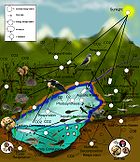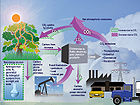- Chemosynthesis
-
In biochemistry, chemosynthesis is the biological conversion of one or more carbon molecules (usually carbon dioxide or methane) and nutrients into organic matter using the oxidation of inorganic molecules (e.g. hydrogen gas, hydrogen sulfide) or methane as a source of energy, rather than sunlight, as in photosynthesis. Chemoautotrophs, organisms that obtain carbon through chemosynthesis, are phylogenetically diverse, but groups that include conspicuous or biogeochemically-important taxa include the sulfur-oxidizing gamma and epsilon proteobacteria, the Aquificaeles, the Methanogenic archaea and the neutrophilic iron-oxidizing bacteria.
Many microorganisms in dark regions of the oceans also use chemosynthesis to produce biomass from single carbon molecules. Two categories can be distinguished. In the rare sites at which hydrogen molecules (H2) are available, the energy available from the reaction between CO2 and H2 (leading to production of methane, CH4) can be large enough to drive the production of biomass. Alternatively, in most oceanic environments, energy for chemosynthesis derives from reactions in which substances such as hydrogen sulfide or ammonia are oxidized. This may occur with or without the presence of oxygen.
Many chemosynthetic microorganisms are consumed by other organisms in the ocean, and symbiotic associations between chemosynthesizers and respiring heterotrophs are quite common. Large populations of animals can be supported by chemosynthetic secondary production at hydrothermal vents, methane clathrates, cold seeps, and whale falls.
It has been hypothesized that chemosynthesis may support life below the surface of Mars, Jupiter's moon Europa, and other planets.[1]
Giant tube worms use bacteria to react hydrogen sulfide with oxygen as a source of energy.
Some reactions produce sulfur, such as:
Hydrogen sulfide chemosynthesis: CO2 + O2 + 4H2S → CH2O + 4S + 3H2O
(CH2O is used to mean carbohydrate, not formaldehyde.)
Instead of releasing oxygen gas as in photosynthesis, solid globules of sulfur are produced. In bacteria that can do this, such as purple sulfur bacteria, yellow globules of sulfur are present and visible in the cytoplasm.
Contents
Discovery
In 1890, Sergei Nikolaevich Vinogradskii (or Winogradsky) proposed a novel life process called chemosynthesis. His discovery suggested that some microbes could live solely on inorganic matter and emerged during his physiological research in the 1880s in Strassburg and Zurich on sulfur, iron, and nitrogen bacteria.
This was confirmed nearly 90 years later, when hydrothermal ocean vents were predicted to exist in 1970s. The hot springs and strange creatures were discovered by Alvin, the world's first deep-sea submersible, in 1977 at the Galapagos Rift. At about the same time, Harvard graduate student Colleen Cavanaugh proposed chemosynthetic bacteria that oxidize sulfides or elemental sulfur as a mechanism by which tube worms could survive near hydrothermal vents. Cavanaugh later managed to confirm that this was indeed the method by which the worms could thrive, and is generally credited with the discovery of chemosynthesis.[citation needed]
A 2004 television series hosted by Bill Nye named chemosynthesis as one of the 100 greatest scientific discoveries of all time.[2]
Use of term in molecular nanotechnology
The term chemosynthesis is also used in molecular nanotechnology broadly to refer to any chemical synthesis where reactions occur due to random thermal motion, a class which encompasses almost all of modern synthetic chemistry. The human-authored processes of chemical engineering are accordingly represented as biomimicry of the natural phenomena above, and the entire class of non-photosynthetic chains by which complex molecules are constructed is described as chemo-.
This form of engineering is then contrasted with mechanosynthesis, a hypothetical process where individual molecules are mechanically manipulated to control reactions to human specification. Since photosynthesis and other natural processes create extremely complex molecules to the specifications contained in RNA and stored long-term in DNA form, advocates of molecular engineering claim that an artificial process can likewise exploit a chain of long-term storage, short-term storage, enzyme-like copying mechanisms similar to those in the cell, and ultimately produce complex molecules which need not be proteins. For instance, sheet diamond or carbon nanotubes could be produced by a chain of non-biological reactions that have been designed using the basic model of biology.
Use of the term chemosynthesis reinforces the view that this is feasible by pointing out that several alternate means of creating complex proteins, mineral shells of mollusks and crustaceans, etc., evolved naturally, not all of them dependent on photosynthesis and a food chain from the sun via chlorophyll. Since more than one such pathway exists to creating complex molecules, even extremely specific ones such as proteins edible to fish, the likelihood of humans being able to design an entirely new one is considered (by these advocates) to be near certainty in the long run, and possible within a generation.
See also
References
- ^ Chela-Flores, J. (2000): "Terrestrial microbes as candidates for survival on Mars and Europa", in: Seckbach, Joseph (ed.) Journey to Diverse Microbial Worlds: Adaptation to Exotic Environments, Springer, pp. 387–398. ISBN 0792360206
- ^ IMDB "100 Greatest Discoveries" (2004)
External links
Categories:- Biological processes
- Metabolism
- Biology
- Environmental microbiology
Wikimedia Foundation. 2010.


